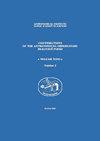大质量双星的爆炸性生命
IF 0.2
4区 物理与天体物理
Q4 ASTRONOMY & ASTROPHYSICS
Contributions of the Astronomical Observatory Skalnate Pleso
Pub Date : 2020-04-06
DOI:10.31577/caosp.2020.50.2.472
引用次数: 0
摘要
大质量恒星主要是作为双星(或更高的多重星)系统的成员诞生的,伴星的存在可以显著地改变它们的生命和最终命运。因此,任何观测到的大质量恒星或相关瞬态恒星样本都可能受到双星效应的显著影响。在这里,我们关注的是大质量双星演化与核心坍缩超新星事件之间的关系。在绝大多数情况下,发生在双星系统中的第一次核心坍缩事件会解除两颗恒星的束缚。研究伴星的数量,无论是在超新星的位置,还是在爆炸后很长一段时间内作为“寡妇”的恒星,都可以用来约束双星祖先之前的轨道演化,以及它们前伴星的爆炸物理。具体地说,“寡居”恒星的数量可能会在没有看到黑洞和可能与它们形成相关的瞬变的情况下,为黑洞出生踢的典型振幅提供统计约束。双星性对超新星子类型的预测数量也有很大的影响,包括富氢的II型超新星,在爆炸中有很大一部分富氢恒星要么是合并产物,要么是吸积体。本文章由计算机程序翻译,如有差异,请以英文原文为准。
The explosive life of massive binaries
Massive stars are born predominantly as members of binary (or higher multiplicity) systems, and the presence of a companion can significantly alter their life and final fate. Therefore, any observed sample of massive stars or associated transients is likely to be significantly influenced by the effects of binarity. Here, we focus on the relationship between massive binary evolution and core-collapse supernova events. In the vast majority of the cases, the first core-collapse event happening in a binary system unbinds the two stars. Studying the population of companion stars, either at the supernova site, or as "widowed" stars long after the explosion, can be used to constrain the previous orbital evolution of the binary progenitor, and explosion physics of their former companion. Specifically, the population of "widowed" stars might provide statistical constraints on the typical amplitude of black hole natal kicks without seeing neither the black holes nor the transient possibly associated with their formation. Binarity also has a large impact on the predicted population of supernova sub-types, including hydrogen-rich type II supernovae, with a significant fraction of hydrogen-rich stars at explosions being either merger products or accretors.
求助全文
通过发布文献求助,成功后即可免费获取论文全文。
去求助
来源期刊
CiteScore
1.10
自引率
20.00%
发文量
4
审稿时长
>12 weeks
期刊介绍:
Contributions of the Astronomical Observatory Skalnate Pleso" (CAOSP) is published by the Astronomical Institute of the Slovak Academy of Sciences (SAS). The journal publishes new results of astronomical and astrophysical research, preferentially covering the fields of Interplanetary Matter, Stellar Astrophysics and Solar Physics. We publish regular papers, expert comments and review contributions.

 求助内容:
求助内容: 应助结果提醒方式:
应助结果提醒方式:


